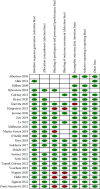Physical and Rehabilitation Therapy for Overactive Bladder in Women: A Systematic Review and Meta-Analysis
- PMID: 36704247
- PMCID: PMC9833926
- DOI: 10.1155/2023/6758454
Physical and Rehabilitation Therapy for Overactive Bladder in Women: A Systematic Review and Meta-Analysis
Abstract
Objective: To compare the effects of different physical and rehabilitation therapies on women with overactive bladder (OAB).
Design: Network meta-analysis. Data source: The Embase, Scopus, and PubMed databases were systematically searched from their inception to June 22, 2022. We included only RCTs, with no language restrictions. Articles in the reference lists and related studies were thoroughly reviewed. Review Methods. This network meta-analysis included related studies on different physical and rehabilitation therapies for OAB. Data were extracted independently from the included randomized controlled trials by two authors, and they used the Cochrane Collaboration's tool to evaluate the risk of bias. We used RevMan to assess the risk assessment of research bias. This network meta-analysis was performed using the Stata software. We completed the review in accordance with the PRISMA items for systematic reviews and meta-analyses statement.
Results: Twelve randomized controlled trials involving 637 patients were included in this meta-analysis. All physical and rehabilitation therapies improved daytime micturition frequency and nocturia frequency in OAB patients. Percutaneous tibial nerve stimulation (PTNS), BT + ES, and BT + BF + ES are better interventions for OAB treatment. There were no significant differences in PTNS, BT + ES, and BT + BF + ES.
Conclusion: All physical and rehabilitation therapies can improve daytime micturition and nocturia frequency in OAB. PTNS, BT + ES, and BT + BF + ES were the priority therapies.
Copyright © 2023 Jingwen Bai et al.
Conflict of interest statement
The authors declare that there are no conflicts of interest in publishing this article.
Figures








Similar articles
-
Acupuncture for treating overactive bladder in adults.Cochrane Database Syst Rev. 2022 Sep 23;9(9):CD013519. doi: 10.1002/14651858.CD013519.pub2. Cochrane Database Syst Rev. 2022. PMID: 36148895 Free PMC article.
-
Anticholinergic drugs versus non-drug active therapies for non-neurogenic overactive bladder syndrome in adults.Cochrane Database Syst Rev. 2012 Dec 12;12(12):CD003193. doi: 10.1002/14651858.CD003193.pub4. Cochrane Database Syst Rev. 2012. PMID: 23235594 Free PMC article.
-
Efficacy of percutaneous and transcutaneous posterior tibial nerve stimulation on idiopathic overactive bladder and interstitial cystitis/painful bladder syndrome: A systematic review and meta-analysis.Neurourol Urodyn. 2022 Feb;41(2):539-551. doi: 10.1002/nau.24864. Epub 2022 Jan 15. Neurourol Urodyn. 2022. PMID: 35032328
-
Electrical stimulation with non-implanted electrodes for overactive bladder in adults.Cochrane Database Syst Rev. 2016 Apr 2;4:CD010098. doi: 10.1002/14651858.CD010098.pub3. Cochrane Database Syst Rev. 2016. Update in: Cochrane Database Syst Rev. 2016 Dec 09;12:CD010098. doi: 10.1002/14651858.CD010098.pub4. PMID: 27037009 Updated.
-
Electrical stimulation with non-implanted electrodes for overactive bladder in adults.Cochrane Database Syst Rev. 2016 Dec 9;12(12):CD010098. doi: 10.1002/14651858.CD010098.pub4. Cochrane Database Syst Rev. 2016. PMID: 27935011 Free PMC article.
Cited by
-
Sacral and Implantable Tibial Neuromodulation for the Management of Overactive Bladder: A Systematic Review and Meta-analysis.Adv Ther. 2025 Jan;42(1):10-35. doi: 10.1007/s12325-024-03019-0. Epub 2024 Oct 30. Adv Ther. 2025. PMID: 39476308 Free PMC article.
-
Effectiveness of transcutaneous tibial nerve stimulation on overactive bladder treatment.Pak J Med Sci. 2025 Jun;41(6):1629-1637. doi: 10.12669/pjms.41.6.11658. Pak J Med Sci. 2025. PMID: 40621528 Free PMC article.
References
-
- Haylen B. T., de Ridder D., Freeman R. M., et al. An international urogynecological association (IUGA)/international continence society (ICS) joint report on the terminology for female pelvic floor dysfunction. Neurourology and Urodynamics . 2010;29(1):4–20. doi: 10.1002/nau.20798.19941278 - DOI - PubMed
-
- Moreira E. D., Neves R. C. S., Neto A. F., et al. A population-based survey of lower urinary tract symptoms (LUTS) and symptom-specific bother: results from the Brazilian LUTS epidemiology study (BLUES) World Journal of Urology . 2013;31(6):1451–1458. doi: 10.1007/s00345-013-1057-8.23515960 - DOI - PubMed
Publication types
MeSH terms
LinkOut - more resources
Full Text Sources
Medical
Miscellaneous
